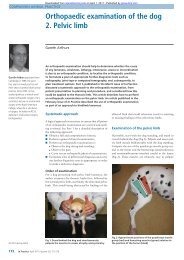FELINE PYOTHORAX - Actualidad Veterinaria
FELINE PYOTHORAX - Actualidad Veterinaria
FELINE PYOTHORAX - Actualidad Veterinaria
You also want an ePaper? Increase the reach of your titles
YUMPU automatically turns print PDFs into web optimized ePapers that Google loves.
THORACENTESIS<br />
• If the patient is severely dyspneic, sedation is generally<br />
not needed; however, mild sedation may be<br />
necessary in fractious patients. The patient should<br />
be well restrained.<br />
• Surgically prep the ventral thoracic wall between<br />
rib spaces 7 to 9 to just above the costochondral<br />
junctions.<br />
• Attach an over-the-needle catheter to an extension<br />
line (or use a butterfly catheter) connected to a<br />
three-way stopcock and syringe.<br />
• Insert the catheter into the thoracic cavity just<br />
cranial to the rib, and gently aspirate fluid. The<br />
person holding the catheter should rest a hand<br />
against the body wall so that any catheter movement<br />
will coincide with the normal breathing<br />
movement of the body. If a butterfly catheter is<br />
being used, the needle should be immediately<br />
withdrawn if it is felt against the lung tissue.<br />
It is important to remember that differentiating<br />
between pyothorax and the transudate and nonseptic<br />
exudate categories (especially FIP and chylothorax)<br />
can be confusing if antibiotics have previously been<br />
administered to the patient. The remarkable cellularity<br />
and neutrophilia of pyothorax fluid in combination<br />
with the presence of intracellular bacteria is the most<br />
distinguishing criterion for diagnosis.<br />
TREATMENT<br />
RECOMMENDATIONS<br />
Initial Treatment<br />
• Thoracentesis (see box above) should be performed<br />
immediately to stabilize the patient and obtain diagnostic<br />
samples.<br />
• Unilateral chest tube placement (see box on right)<br />
and continuous or intermittent (every 2 to 4 hours)<br />
suction is recommended. Bilateral chest tube placement<br />
is indicated if the mediastinum is complete,<br />
there is pocketing of the effusion, or if effusion persists<br />
after drainage with the unilateral tube. A local<br />
anesthetic block with bupivacaine (1 mg/kg) may<br />
be performed at the time of tube placement.<br />
• Radiography should be repeated to evaluate the<br />
completeness of thoracic drainage and the position<br />
of the chest tube.<br />
• Broad-spectrum, intravenous antimicrobial therapy<br />
with anaerobic coverage should be instituted while<br />
culture results are pending: $$<br />
— Ampicillin with sulbactam (22 mg/kg slow IV<br />
q8h) is sufficient in most cases.<br />
— If infection with resistant gram-negative organisms<br />
is a concern, more aggressive therapy with<br />
a fluoroquinolone (ciprofloxacin, 10 mg/kg IV<br />
q24h) may be necessary. Some clinicians add<br />
STANDARDS of CARE: EMERGENCY AND CRITICAL CARE MEDICINE<br />
CHEST TUBE PLACEMENT<br />
• The patient should be well restrained and highly<br />
sedated or anesthetized with appropriate monitoring.<br />
A local anesthetic block (bupivacaine, 1<br />
mg/kg [may be diluted with a small amount of<br />
sterile saline] injected locally) should be performed.<br />
Thoracostomy tube placement without<br />
general anesthesia should occur only in animals in<br />
critical condition.<br />
• Premeasure the chest tube to the desired placement<br />
within the thoracic cavity.<br />
• The lateral thorax should be generously clipped<br />
and surgically prepped. The free skin is pulled<br />
cranially to offset the skin and body wall incisions<br />
to prevent pneumothorax. Identify intercostal<br />
spaces 7 to 9. Using a blade, make a small skin<br />
incision in the dorsal two-thirds of the thorax<br />
between intercostal spaces 7 to 9.<br />
• Using a hemostat, gently dissect to the thoracic<br />
wall without penetrating into the pleural space.<br />
The chest tube is advanced carefully through the<br />
thoracic wall into the pleural space using hemostats<br />
or a stylet and then guided ventrocranially as<br />
it is advanced into the thoracic cavity.<br />
• Clamp the tube to room air immediately after<br />
placement, and suture it in place.<br />
• Immediately apply suction to the tube to remove<br />
air that has gained entry during placement and<br />
any additional fluid remaining after thoracentesis.<br />
Aspiration pressure should not exceed 5–10 ml<br />
with a syringe or more than 15–20 cm H 2O using<br />
continuous suction.<br />
• Radiographs should be taken to ensure correct<br />
placement of the chest tube and to evaluate the<br />
amount of pleural fluid remaining. The tube may<br />
need to be repositioned if there is radiographic<br />
evidence of pleural effusion after tube aspiration,<br />
or bilateral tubes may be needed to achieve complete<br />
fluid removal.<br />
• The tube is then attached to a stopcock or adaptor<br />
to accommodate the type of suction that will be<br />
employed.<br />
• Secure the tube connections with surgical steel<br />
wire, and double-check for leakage or loose<br />
connections.<br />
• A light, loose bandage can be used to help<br />
secure the tube, and an Elizabethan collar should<br />
be placed on the patient. Be cautious not to<br />
cause chest compression and breath restriction<br />
with the bandage. Monitor the tube and bandage<br />
regularly.<br />
• The highest standards of patient care should be<br />
implemented. This should include wearing gloves<br />
when handling the patient and chest tube, keeping<br />
all ports capped at all times, and wiping ports<br />
with alcohol before administering local anesthetics<br />
or lavage fluid.<br />
clindamycin (11 mg/kg SQ or PO q12h).<br />
— Antimicrobial therapy can be altered as needed<br />
once aerobic and anaerobic culture results are<br />
available.<br />
9



